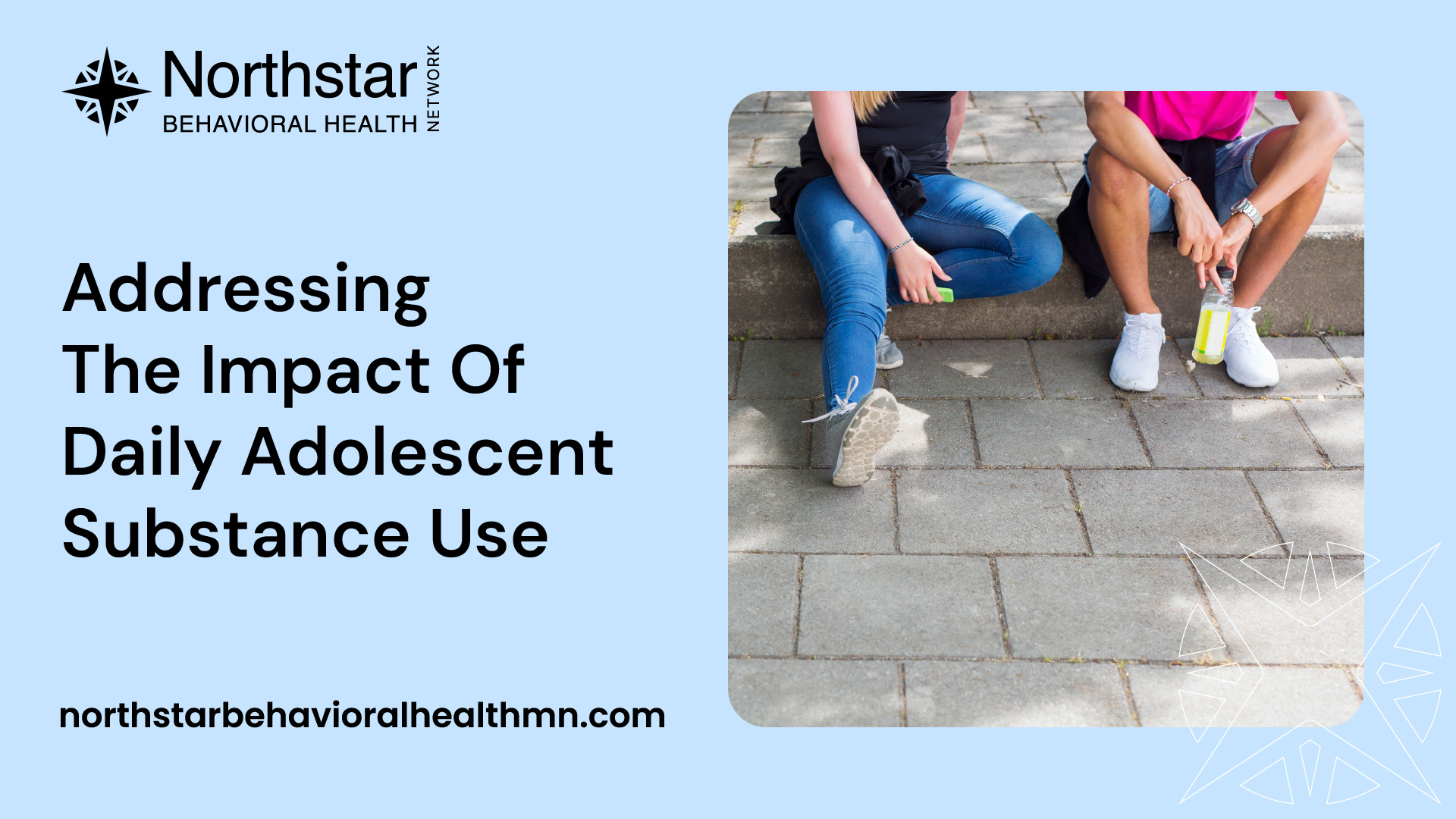September 2, 2024
Addressing The Impact Of Daily Adolescent Substance Use
Discover alarming new findings on daily adolescent substance use.


Understanding Adolescent Substance Use
Adolescent substance use is a pressing issue that requires our attention and understanding. This section aims to shed light on the scope of the problem and the impact it has on adolescents.
Scope of the Issue
The prevalence of substance use among adolescents is a cause for concern. According to a new study, alarming information has emerged regarding daily adolescent substance use. The study reveals that a significant number of adolescents engage in substance use on a daily basis, which can have detrimental effects on their physical and mental well-being.
To better comprehend the scope of the issue, let's take a look at some statistics:
These figures highlight the substantial number of adolescents who are exposed to and using various substances on a daily basis. It is crucial to address this issue promptly to prevent further negative consequences.
Impact on Adolescents
Daily substance use can have severe consequences for adolescents. It not only affects their physical health but also has a significant impact on their mental and emotional well-being. Some of the consequences associated with daily substance use among adolescents include:
- Impaired Brain Development: The adolescent brain is still developing, and substance use can disrupt this process, leading to long-term cognitive impairments.
- Academic Performance Decline: Substance use can hinder academic performance, resulting in poor grades, decreased motivation, and decreased interest in school-related activities.
- Mental Health Issues: Adolescents who use substances daily are at a higher risk of developing mental health disorders such as anxiety, depression, and substance use disorders later in life.
- Increased Risky Behaviors: Daily substance use is often associated with engaging in risky behaviors such as unsafe sexual practices, driving under the influence, and involvement in criminal activities.
- Social and Relationship Problems: Substance use can strain relationships with family and friends, leading to conflicts, isolation, and a lack of social support.
Understanding the impact of daily substance use on adolescents is crucial for developing effective strategies to address this issue. By recognizing the alarming information revealed by recent studies, we can take the necessary steps to prevent, intervene, and support adolescents in making healthier choices. For resources and assistance in dealing with substance use, refer to our article on resources for assistance.
New Study Findings
Recent studies have shed light on the alarming impact of daily substance use among adolescents. These findings provide valuable insight into the prevalence and consequences of this concerning behavior.
Alarming Information Revealed
The new study has revealed alarming information regarding daily substance use among adolescents. It indicates that a significant number of adolescents engage in daily substance use, putting their health and well-being at risk. The study highlights the need for increased awareness and intervention to address this growing issue.
Consequences of Daily Substance Use
Daily substance use among adolescents can have severe consequences on their physical and mental health, as well as their overall development. The study findings indicate several potential consequences, including:
- Impaired Cognitive Function: Daily substance use during adolescence can impair cognitive function, affecting memory, attention, and decision-making abilities. This can have long-term consequences on academic performance and future prospects.
- Increased Risk of Mental Health Disorders: Daily substance use is associated with an increased risk of developing mental health disorders, such as anxiety and depression. Substance use can exacerbate existing mental health conditions and make it more challenging for adolescents to seek help.
- Social and Relationship Issues: Daily substance use can lead to strained relationships with family, friends, and peers. It may isolate adolescents and impact their ability to form healthy social connections.
- Higher Risk of Addiction: Regular substance use during adolescence increases the risk of developing addiction later in life. The adolescent brain is particularly vulnerable to the effects of substances, making early intervention crucial.
- Negative Impact on Physical Health: Daily substance use can have detrimental effects on physical health, including damage to vital organs, impaired immune function, and an increased risk of accidents and injuries.
These study findings emphasize the urgency of addressing daily substance use among adolescents. Early intervention and support systems are essential for mitigating the potential consequences and promoting healthier choices. For resources and assistance related to adolescent substance use, refer to our article on resources for assistance.
Addressing the Problem
When it comes to adolescent substance use, it is crucial to address the issue promptly to prevent further harm. Two key aspects of addressing the problem are the importance of early intervention and establishing support systems for adolescents.
Importance of Early Intervention
Early intervention plays a vital role in addressing adolescent substance use. Recognizing the signs of substance use at an early stage allows for timely intervention and increases the chances of successful recovery. By identifying and addressing the problem early on, adolescents can receive the necessary support and resources to overcome their substance use issues.
Early intervention also helps prevent the escalation of substance use and the associated negative consequences. It allows for the implementation of appropriate strategies and interventions to mitigate the harmful effects of substance use on adolescents' physical and mental health.
Support Systems for Adolescents
Establishing strong support systems is essential for addressing adolescent substance use effectively. Adolescents need a network of individuals who can provide guidance, understanding, and assistance throughout their recovery journey.
Support systems can consist of various individuals, including family members, friends, mentors, and healthcare professionals. These individuals can offer emotional support, encouragement, and practical assistance to help adolescents navigate the challenges of overcoming substance use.
In addition to personal support systems, there are also resources available in the form of support groups, counseling services, and treatment centers. These resources provide a structured and supportive environment where adolescents can receive professional help, learn coping strategies, and connect with others who have similar experiences. For more information on resources and assistance, check out our article on resources for assistance.
By emphasizing the importance of early intervention and establishing robust support systems, we can effectively address adolescent substance use. Timely intervention and a strong support network provide adolescents with the necessary tools and guidance to overcome their substance use challenges and lead healthier, more fulfilling lives.
Seeking Help
When it comes to addressing adolescent substance use, seeking help is a crucial step in the process of recovery. Recognizing the signs of substance use and knowing where to find resources for assistance are vital for individuals struggling with addiction.
Recognizing the Signs of Substance Use
Recognizing the signs of substance use in adolescents can be challenging, as some of the symptoms may overlap with normal teenage behavior. However, there are common indicators that could signal substance use:
- Sudden changes in behavior, mood, or attitude
- Decline in academic performance or skipping school
- Loss of interest in activities once enjoyed
- Withdrawal from family and friends
- Neglecting personal appearance and hygiene
- Bloodshot eyes, dilated or constricted pupils
- Unexplained financial issues or stealing money
- Drug paraphernalia or evidence of substance use
It's important to approach the situation with empathy and understanding. If you suspect a young person may be struggling with substance use, it is crucial to seek professional help and guidance.
Resources for Assistance
Fortunately, there are resources available to help individuals struggling with substance use. Here are some key avenues to explore:
- School Counselors: School counselors can provide guidance and support for adolescents facing substance use issues. They can offer confidential counseling sessions, connect students with appropriate resources, and involve parents or guardians in the process.
- Support Groups: Peer support groups, such as Alcoholics Anonymous (AA) or Narcotics Anonymous (NA), can provide a safe space for individuals to share their experiences and receive support from others who have gone through similar challenges.
- Therapists and Counselors: Licensed therapists and counselors who specialize in addiction can provide individual therapy sessions to address the underlying causes of substance use and develop coping strategies.
- Hotlines and Helplines: Various hotlines and helplines are available around the clock to provide immediate assistance and guidance. These helplines are staffed by trained professionals who can offer support, information, and referrals for treatment options.
- Online Resources: Online resources, such as websites and forums dedicated to addiction recovery, can provide valuable information and support. These platforms may offer educational materials, self-help tools, and forums for connecting with others in similar situations.
Remember, seeking help is a courageous step towards recovery. It's important to reach out to professionals and utilize the available resources to guide individuals on their journey to sobriety. For more information on addiction treatment and recovery, explore our article on is thirty days really the magic number?.
Strategies for Prevention
Preventing adolescent substance use is a crucial step in addressing the alarming impact it has on young individuals. By implementing effective strategies, we can work towards creating a healthier and safer environment for adolescents. Two key strategies for prevention include education and awareness programs, as well as building resilience in adolescents.
Education and Awareness Programs
Education plays a vital role in preventing adolescent substance use. By providing accurate and comprehensive information about the risks and consequences of substance use, we can empower young individuals to make informed decisions. Education and awareness programs can take various forms, such as school-based initiatives, community campaigns, or online resources.
These programs aim to educate adolescents about the dangers of substance use, including the impact on physical and mental health, academic performance, and relationships. They also highlight the importance of making healthy choices and developing effective coping mechanisms to deal with stress and peer pressure.
By incorporating interactive activities, open discussions, and real-life examples, education and awareness programs can engage adolescents and increase their understanding of the risks associated with substance use. Additionally, these programs can provide resources and tools for seeking help and support, which we will discuss further in the section on Seeking Help.
Building Resilience in Adolescents
Building resilience is another crucial strategy for preventing adolescent substance use. Resilience refers to an individual's ability to adapt and bounce back from challenging situations. By equipping adolescents with the necessary skills and support systems, we can help them develop resilience and reduce their vulnerability to substance use.
There are several ways to foster resilience in adolescents. One approach is to focus on building healthy coping mechanisms and stress management skills. Teaching adolescents alternative ways to manage stress, such as engaging in physical activity, practicing mindfulness, or seeking support from trusted adults, can help them navigate difficult situations without turning to substances.
Furthermore, promoting positive self-esteem and self-confidence is essential in building resilience. Encouraging adolescents to develop a strong sense of self-worth and supporting their individual strengths and interests can contribute to their overall well-being and reduce the likelihood of turning to substances as a means of escape or self-medication.
By combining education and awareness programs with efforts to build resilience in adolescents, we can create a multi-faceted approach to prevention. These strategies work together to empower young individuals, provide them with the necessary knowledge and skills, and create a supportive environment that promotes healthy choices.
In the next section, we will discuss the importance of recognizing the signs of substance use and provide resources for assistance in Seeking Help.
Moving Forward
After acknowledging the alarming impact of daily adolescent substance use, it is important to focus on moving forward and finding ways to address the issue effectively. Encouraging positive choices and promoting healthy lifestyles are key aspects of this process.
Encouraging Positive Choices
One of the essential steps in addressing adolescent substance use is to encourage positive choices. This involves providing adolescents with the knowledge and skills to make informed decisions about their well-being. Education and awareness programs play a vital role in empowering adolescents to understand the risks and consequences associated with substance use.
These programs can provide information about the harmful effects of substance abuse, the importance of setting boundaries and making responsible choices, and the availability of resources for assistance. By equipping adolescents with the necessary tools, we can empower them to resist peer pressure and make choices that align with their long-term goals and aspirations.
Promoting Healthy Lifestyles
In addition to encouraging positive choices, promoting healthy lifestyles is crucial in addressing adolescent substance use. This approach focuses on creating an environment that supports physical, emotional, and mental well-being, reducing the likelihood of turning to substances as a coping mechanism.
Promoting healthy lifestyles involves various aspects, including:
- Physical Activity: Encouraging regular physical activity can have a positive impact on overall well-being. Engaging in sports or other physical activities not only promotes physical health but also helps manage stress and enhance mood.
- Healthy Relationships: Building and nurturing healthy relationships is essential for adolescents. Encouraging open communication, trust, and a supportive network of friends and family can contribute to their emotional well-being and reduce the likelihood of turning to substances for solace.
- Stress Management: Teaching effective stress management techniques can help adolescents cope with the challenges they may face. Techniques such as deep breathing exercises, mindfulness, and engaging in hobbies or activities they enjoy can provide healthier alternatives to dealing with stress.
- Mental Health Support: Addressing mental health concerns is crucial in promoting healthy lifestyles. Providing access to mental health resources, counseling services, and support groups can help adolescents navigate their emotions and challenges in a healthier way.
By promoting positive choices and healthy lifestyles, we can create an environment that supports adolescents in making informed decisions and reducing the risk of substance use. It is important to remember that addressing substance use requires a multi-faceted approach that involves early intervention, support systems, and prevention strategies. For more information on seeking help and resources for assistance, refer to our article on resources for assistance.
Together, we can work towards creating a healthier future for adolescents, empowering them to make choices that contribute to their overall well-being and success.

.jpg)




.jpg)

